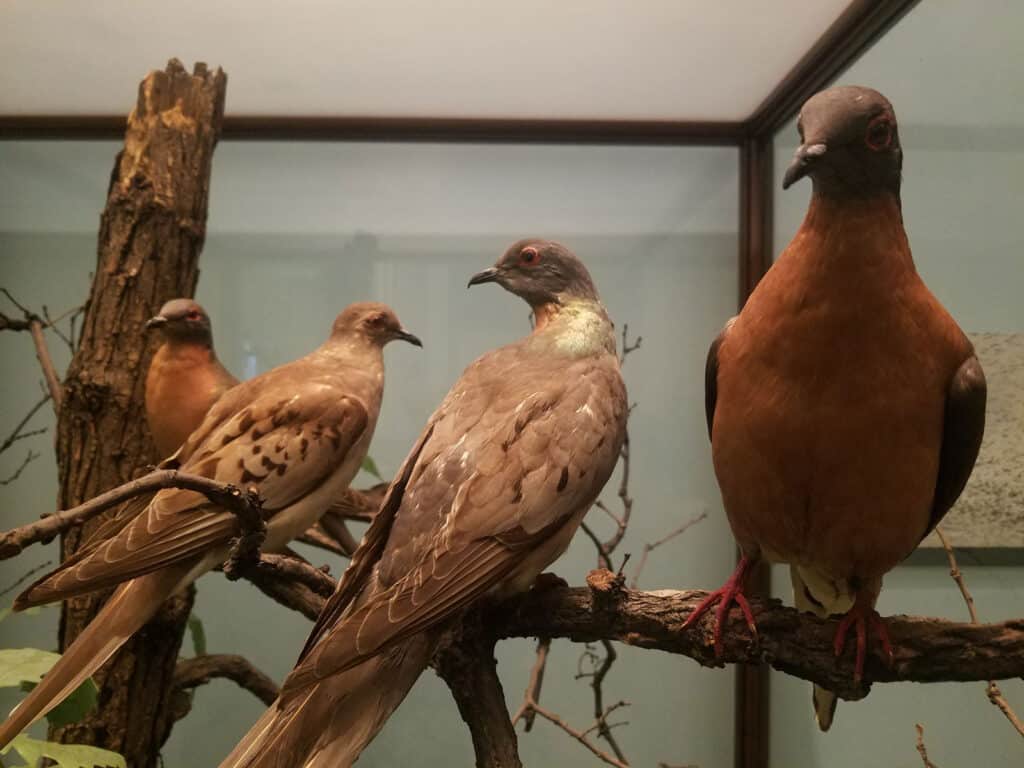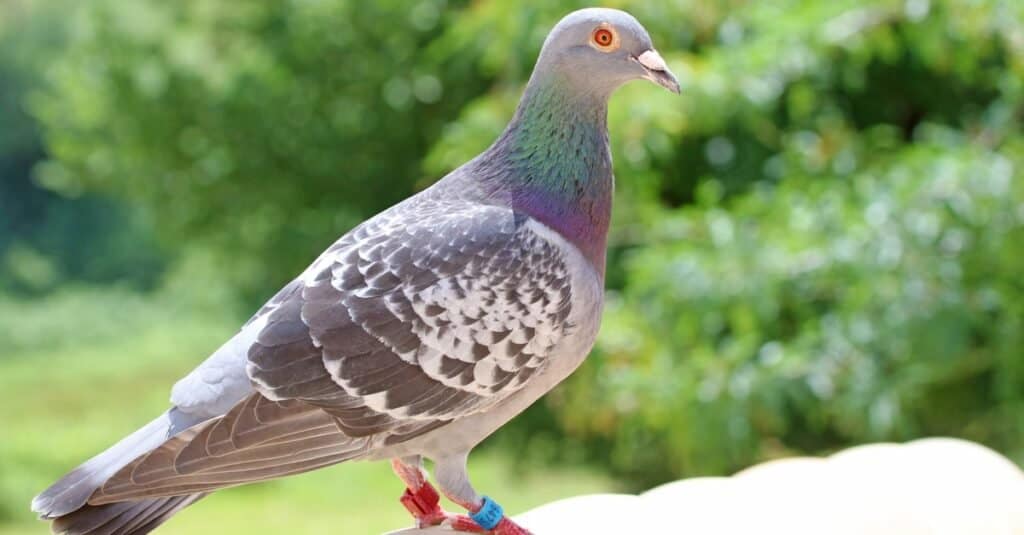Passenger pigeons (Ectopistes migratorius) used to fly in huge flocks across North America. This included Canada, the Midwest, and the eastern United States. Geneticists have shown that the population was stable for 20,000 years, so what exactly happened? How did the passenger pigeon go extinct and when?
Witnesses reported that it took hours for the flight of birds to pass overhead. The sound was reportedly so loud it sounded like thunder and drowned out conversations. Their name comes from the French word for passing by, “passager,” because of the enormity of the flocks that flew overhead.
How did a bird that used to number in the billions go extinct? When did this extinction happen? We’ll dive into the details now.
When Did the Passenger Pigeon Go Extinct?

The last captive passenger pigeon went extinct in 1914.
©ChicagoPhotographer/Shutterstock.com
The passenger pigeon went extinct in 1914. The last individual was a captive pigeon at the Cincinnati Zoo named Martha. Natural populations were gone by the time she died.
She was 29 years old when she passed away, and she never laid a viable egg.
The last known shooting death of a passenger pigeon was in 1900. The pigeon was mounted, and the boy responsible didn’t know what species it was when he shot it.
How Did the Passenger Pigeon Go Extinct?
The passenger pigeon went extinct due to overhunting. The number of birds made it seem like passenger pigeons were an endless meat source, but this proved to be untrue.
While subsistence hunting of passenger pigeons had been occurring for thousands of years, it was the commercialization of pigeon meat that led to their demise. This commercialization happened in response to the convenience of the railroad.
The opening of transcontinental railroads allowed for the quick transport of hunters and their products. They were also hunted mercilessly by farmers trying to protect their crops from complete devastation.
Even when passenger pigeons became harder to find, they were still hunted relentlessly. Their nests were also destroyed, but they never became functionally extinct. Instead, hunters kept at it until they were completely gone.
Passenger pigeons weren’t able to adapt fast enough to a mass murder event. Their survival adaptation was to outnumber predators and overwhelm them, but this only furthered their accessibility to humans. These pigeons were also highly social and nested together, making them easy targets.
The way they conducted themselves as a population made their extinction easier. They nested and roosted in huge groups in forests. As deforestation progressed, it was the last blow needed to drive the passenger pigeon to extinction.
It was hunting and deforestation combined that are to blame for the disappearance of the passenger pigeon. Some scientists have tried to prove that these pigeons were already in decline before hunting took place. Genetic evidence points to a thriving population, however.
What Did the Passenger Pigeon Eat?

Acorns were among the passenger pigeon’s favorite foods.
©Kasabutskaya Nataliya/Shutterstock.com
Passenger pigeons loved to eat tree nuts like beechnuts and acorns. They also took advantage of seasonal berries like grapes, pokeberries, and blueberries. They mixed invertebrates like caterpillars and worms into their diet as well, particularly during the breeding season.
They decimated a variety of crops like buckwheat and corn when their swarms flew in. This triggered a sizeable portion of the hunting that took place across the nation. Farmers saw these pigeons as a pest and treated them as such.
As forests disappeared, passenger pigeons showed the ability to adapt to less desirable food sources like farmed corn. This shows that it wasn’t a lack of food that drove the passenger pigeon to extinction.
Did the Passenger Pigeon Carry Anything?
No, the North American passenger pigeon didn’t carry anything. However, there are pigeons called “carrier pigeons” (Columba livia domestica) that have aided humans in delivering messages. Some of these pigeons have been used to carry messages for centuries.
The ancient Persians were the first to use carrier pigeons, followed by the Greeks and Romans. They were used extensively by Europeans until the development of the telegraph. Once the telegraph was invented, pigeons were mainly used during warfare.
Today’s pigeons are actually homing pigeons. Homing pigeons are famous for their ability to return to their owner’s roost. They’ve been used for centuries in a myriad of situations, delivering messages and small objects.
Homing pigeons used to be involved with the USPS, but this was discontinued as the telegraph and railroad became popular. There still are homing pigeon messaging services owned and operated by private individuals.
Why Are They Called Passenger Pigeons in North America?

Homing pigeons are not the same as passenger pigeons but used to carry things as they are domesticated.
©Ruth Swan/Shutterstock.com
They are called passenger pigeons in North America because their name derives from the French word “passager,” which means to pass. This is about the enormity of their flocks that would pass over humans on their migrations.
Homing pigeons are domesticated rock pigeons, while passenger pigeons were wild pigeons. Because they’re both pigeons, the North American passenger pigeon has sometimes mistakenly been referred to as a homing or carrier pigeon.
Did Pigeons Serve in the Navy?
Yes, pigeons served in the Navy. They were used as late as WWII and as early as the 1880s. Homing pigeons relayed messages for the Navy until all ships were able to utilize telegraphs. Around 1902, the use of pigeons by the Navy stopped.
During their service, they were responsible for transporting important information from ships to the mainland. Some messages and coordinates these homing pigeons carried gave strategic advantages and saved lives.
Some pigeons used to carry messages were uniformed with a chest pocket made by Maidenform.
Do Drug Smugglers Use Pigeons?
Yes, drugs are smuggled with pigeons. They aren’t using the North American passenger pigeon because it’s extinct, but other pigeons are used to smuggle illicit substances. This is a contemporary occurrence around the world.
A few of these drug birds have been found at border crossings or leaving jails. Some are intercepted alive, while some are shot down. No one is certain how many drug smuggling pigeons exist today.
The photo featured at the top of this post is © ChicagoPhotographer/Shutterstock.com
Thank you for reading! Have some feedback for us? Contact the AZ Animals editorial team.






